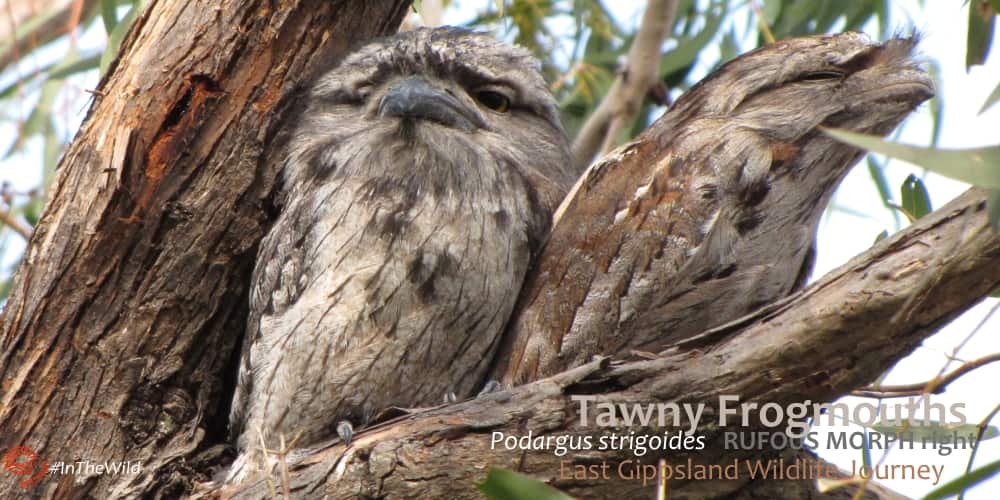Someone asked me the other day: “How do Wildlife Guides know so much?”
The Australian Bush is our workplace, and learning on the job is continual and infinite. You can never learn everything nature has to teach, but it is tremendous fun to try.
During a walk on a recent Wildlife Journey in East Gippsland we came across a deceased Tawny Frogmouth. My first reaction was sadness for the loss of such a beautiful bird.
My second reaction was curiosity. How did she* die? We looked around the scene – it was in the middle of the bush, nowhere near a road or powerline. The ground around the dead bird was undisturbed. She lay face down, wings outstretched, head to one side – as if she had fallen from the tree and died almost immediately.

Feather detail: upper back
I examined the feathers visually for any sign of major damage. Feathers are strong, light and pliant and can visually hide an injury. Some major trauma (like vehicle strike, collision with object) will break a group of feathers in one location, and severe illness will often affect the appearance of the feathers, making them dull or misshapen.
All I could see were healthy feathers and some normal wear on the tips of the primaries.

Outstretched left wing
I rolled the Tawny Frogmouth over gently. A large pink patch, bare of feathers, in the middle of the chest caught my attention. Could this be the fatal injury?

Chest region showing brood patch
The bare patch was symmetrical, and placed right at the deepest point of the breast. The skin looked healthy and undamaged. There were no broken feather shafts.
The bare patch on this Tawny Frogmouth was a brood patch, not an injury. She was sitting on a nest recently.
Brood patches develop in many types of birds as a way of transferring heat to their eggs. The feathers in a region of the breast or belly fall out (or in some species are pulled out) just before nesting. The brood patch stays bare for the whole incubation time, and sometimes for weeks after the chicks hatch. In some birds the brood patch even develops increased blood flow during incubation.

Brood patch detail
Tawny Frogmouth pairs mate for life, and male and female share the care of their chicks. The male sits on the nest in the daytime, and they share brooding in the nighttime. Both sexes develop brood patches at this time.
I looked around for a nest. Nothing. It was December, and we have records of Tawny Frogmouths on nests in August, September & October*. Tawny Frogmouths sit on the eggs for a month, and chicks leave the nest after another month.
Hopefully she had fledged chicks by now, that were being looked after her partner.
Next year her partner might have a new spouse – one who is keen for a home and a chance to breed. In nature, death is an opportunity for new life.
It is sad that this Tawny Frogmouth died, but her death was not wasted. She educated me, and gave me a reason to learn more about – and hopefully help – her kind.
The best way to learn about nature is to explore, investigate and read. If you see something interesting, take photos and when you get back home read and learn about it. Then share what you’ve seen and learned so that others, and nature, can benefit. Your observation could help with the conservation of that species.
TAWNY FROGMOUTH CONSERVATION STATUS:
Here’s some websites that you can submit sightings and photographs to (even if you’re not sure what species it is):
iNaturalist.org
eBird.org
ala.org.au
Note: if you find a dead endangered bird with a brood patch, it is worthwhile notifying the Threatened Bird Network at BirdLife Australia tbn@birdlife.org.au or T: (03) 9347 0757 as soon as possible. There is a chance that eggs or chicks could be saved if found.
LIST OF ENDANGERED BIRDS
NOTES & REFERENCES:
* I an unsure of the sex of this bird, so I’ve chosen the feminine for ease of reading.
*Our nesting records are from the You Yangs near Melbourne – the majority of nesting appears to occur in these months in the south. Raymond Island is probably similar.
Read about Tawny Frogmouths here: http://www.birdlife.org.au/bird-profile/tawny-frogmouth
and more about brood patches here: https://web.stanford.edu/group/stanfordbirds/text/essays/Brood_Patches.html

